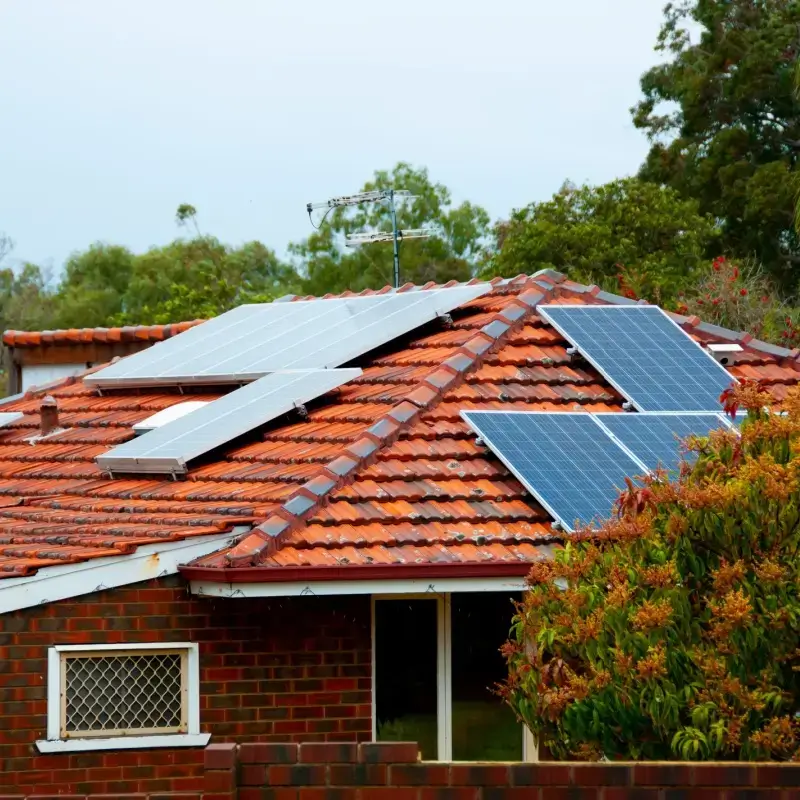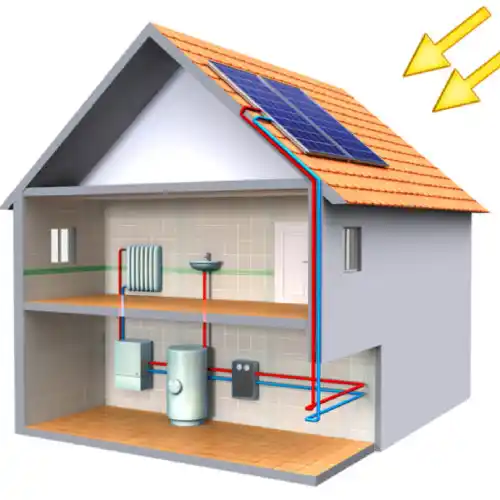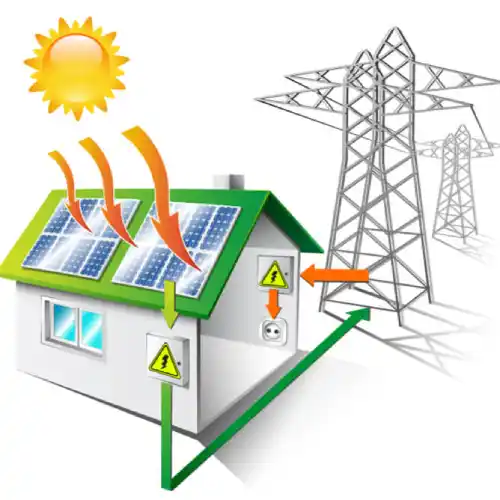Home / Compare Electricity &… / Understanding solar powe…




Key takeaways
- There are two types of solar power systems available for homes in Australia: solar thermal and solar photovoltaic (PV).
- Solar concessions and incentives may be available to help manage the costs of buying and installing solar panels.
- Compare solar feed-in tariffs to make the most out of your solar power system.
Expert tips for managing solar power in your home
Compare the Market’s Head of Energy, Meredith O’Brien, has some tips to help you get the most out of your solar.

Consider investing in a solar battery
Consider investing in a battery to store excess solar power you’ve generated to use later when the sun isn’t out. This lessens your reliance on using energy from the grid and paying additional usage costs.
Plan ahead when using high-energy usage appliances
For appliances that consume a lot of electricity such as dishwashers, washing machines or dryers, keep costs low by running them during the day. If you don’t have a battery, this will help you take advantage of your solar energy. Limiting your electricity usage at night by running appliances during the day may also lower your electricity bills.
Compare solar feed-in tariffs
If you have solar panels, consider shopping around for solar feed-in tariffs as they will vary between retailers. Compare the Market has a free comparison tool to help you compare both solar feed-in tariffs and regular electricity rates in only minutes.
What is solar energy?
Solar energy is a source of electricity created by the heat and light emitted by the sun. We can harness this energy and convert it to electricity, use it to heat water or air and even create solar fuels (like hydrogen); doing any of these produces solar power.1
Solar power currently makes up 16% of Australia’s total electricity generation, the highest of all renewable energy generation sources in 2023.2
How does solar power work in my home?
There are two primary solar energy systems used in Australian households: solar thermal and solar photovoltaic (PV).
Solar thermal

Solar thermal systems turn sunlight into thermal energy to be used for hot water systems in homes or businesses. On a large scale, solar thermal is used for producing electricity via steam and turbines, but this is typically unavailable for households.3
| Pros | Cons |
|---|---|
|
|
Solar photovoltaic

Solar PV (sometimes referred to as rooftop solar) converts solar radiation into electricity through PV panels or modules, which can be installed on a variety of different surfaces but are typically installed on rooftops for households.3
| Pros | Cons |
|---|---|
|
|
How do I know how much electricity my solar panels are generating?
If you have a solar PV system, here are a few ways you could see how much electricity your solar panels are generating:
- Solar inverters may include electricity monitoring, which is often displayed on a screen on the inverter. Along with the power that’s currently being generated by your solar panels, your solar inverter could also measure your daily consumption.
- Smart meters could help you monitor the amount of solar you’re generating, as well as your real-time electricity usage.
- Apps and websites can measure how much solar you’re generating if your inverter or battery has some form of internet connection (e.g. 4G/5G, Wi-Fi, LAN).
About solar energy
Types of solar PV systems
There are three main types of solar PV systems available in Australia:
- On-grid. These systems draw on the electricity generated from your panels and switch to drawing on grid power once the solar energy is used up. They’ll also feed any excess electricity you generate back into the grid; this is where you can consider a solar feed-in tariff (FIT). On-grid systems don’t come with battery storage, and so don’t continue to power the house when the sun isn’t out.
- Off-grid. Off-grid systems operate as their name suggests: completely disconnected from the grid. These systems come equipped with batteries, as they’re generally suited to properties that are too remote and too expensive to connect to the main grid. Because of this, off-grid systems need to have a bigger solar array (arrangement of panels) to both power the house and keep the batteries fully charged.
- Hybrid. Hybrid systems are on-grid systems that also have battery storage; any electricity generated by the panels and not used by the house is then stored in the batteries for those times when the sun isn’t shining (e.g. at night). If the batteries run out, you can still draw electricity from the grid.
Components of a solar power system
It’s all well and good to understand how solar power works and how it becomes electricity, but you should also understand a system’s makeup. We’ve outlined some of the main components of a solar power system below.
| Component | What it does |
|---|---|
| Panels | Arguably the most recognisable part of a solar power system, the solar panels are responsible for capturing the light emitted by the sun and converting it into direct current electricity.5 |
| Solar inverters | Inverters are the key element in a solar power system. They convert the direct current electricity captured by the solar panels into alternating current electricity, which is what our homes run on.5 |
| Monitoring | Your inverter may come with a monitoring system, or you can choose to add one to your solar power setup. A monitoring system allows you to track your system’s power generation, consumption and operations.5 |
| Batteries | Any excess energy generated by your solar panels can be stored in batteries to be used when the system powers down during sun-less times (e.g. night or overcast days). |
| Smart meter | A smart electricity meter is a necessary component to connect your household to the grid if you have solar power. It records excess solar energy exported to the grid, as well as imported energy consumed by your household.5 |
The benefits of solar energy
Solar energy can be more beneficial to the environment than traditional sources of electricity such as energy generated from the burning of fossil fuels. A solar power system can also benefit you and your household, and here’s how:
- It’s a renewable source of energy. As Australia and the rest of the world transitions to clean energy sources, solar power is playing a key role in moving towards these objectives.
- You may lower your carbon footprint. Solar power helps reduce greenhouse gas emissions and minimise fossil fuel dependency.
- It can help reduce your electricity bill. Solar power customers could recoup the initial upfront costs of a three to five kilowatt (kW) PV system without batteries within four to eight years.3 Considering that solar panel systems have a 20-30-year life expectancy,6 generating your own electricity could mean you benefit from reduced electricity bills for years.
Keep in mind you’ll still be required to pay supply charges for being connected to the grid, as well as pay for panel servicing and maintenance. Regular maintenance can ensure your solar panels remain efficient, operate correctly and lessen degradation over time.
What is a solar feed-in tariff?
A solar feed-in tariff (FIT) pays you for the electricity generated from your home solar system that you then feed back into the electricity grid. The main type of solar FIT is net, which pays you for the leftover, unused electricity from your system that you then export to the grid.
The other type of solar FIT is gross, which pays for all the electricity generated by your system, as it’s intended to bypass your home entirely and feed straight back into the grid. Gross solar FITs aren’t generally offered to new solar customers anymore.
Solar FITs are also different between states and territories, and different again between energy retailers within those states. Before switching electricity retailers, be sure to weigh up the tariffs involved (including supply and usage charges) to identify which option is best suited to your specific household.
How do I find the best solar deals?
If you’re in the market, you stand a good chance of finding the best solar-compatible electricity plan by doing your research, shopping around and, most importantly, comparing your options.
When comparing these electricity plans, keep an eye out for the following:
- How much your daily supply charge and general usage rates will be
- Usage charges during demand periods (if applicable)
- How much you’ll be paid through the solar feed-in tariff (FIT) by your retailer
- Any discounts or special offers available (e.g. discounted rates for the first 12 months of your plan) for any usage you need from the grid
- The fees that might be applied to your contract (e.g. connection fees)
- Other plan features (e.g. billing options).
Our energy comparison service can be a great place to get started in your search. Just enter in a few details about yourself and your property, and our service will present you with a range of energy plans to compare and choose from. Simples!
Am I eligible for a solar energy rebate?
As well as potentials savings you could make on your power bill, you could be entitled to a government rebate for your solar system, depending on the state or territory you live in.
- Australian Capital Territory (ACT): For eligible homeowners, the Home Energy Support Program offers a rebate to cover half of your solar installation costs (up to $2,500), as well as an additional rebate to cover half the cost of installing other energy-efficient products such as heat pumps, ceiling insulation, heating and cooling and more (up to $2,500).7
- New South Wales (NSW): The NSW Government offers residential solar battery incentives, where eligible residents can access discounted installation costs of a battery.8 A second incentive offers a discount for connecting your home battery to a Virtual Power Plant (VPP).
- Victoria (VIC): Residents in VIC can apply for the state government’s PV panel and solar hot water system rebate.9 The rental property solar rebate is also available to landlords who wish to install PV panels on their rental property.
Information is current as of November 2024. Read more about rebates and concessions in your state or territory.
Another way to recoup some of the cost of installing solar power is through the Small-scale Renewable Energy Scheme (SRES). By installing an eligible renewable energy system, you earn small-scale technology certificates (STCs). The amount of STCs you’re eligible for will vary depending on factors such as the type of system installed, your location, when you installed your system and more.10
Your solar installer or retailer can typically sell these STCs on your behalf, either through the open market or the STC Clearing House.
How do I choose a solar power system?
Solar power systems are large, intricate, expensive products. It’s therefore vital you choose the right system for your needs. Here are some things you should consider if you’re looking into solar energy for your home.
1. How much energy do you need?
When you search for the right solar power system for your home, you should first determine how much electricity you’ll likely need to generate.
Take a look at your current consumption and the periods when you use most power; your energy bill will typically detail this. This information will then influence the size and number of solar panels your property would likely need.
2. What can impact the cost of solar power systems?
When it comes to purchasing a solar system, the price can vary based on many factors including:
- The cost of equipment and installation
- Where your house is located
- If you’re eligible for solar rebates or incentives
- The number and size of the solar panels installed
- How accessible your roof is, as well as what it’s made of.
3. How much could it potentially help you save?
Saving on electricity bills is one reason why people turn to solar energy to power their homes. Bear in mind, though, that it can still take a few years of having a solar power system before your energy savings exceed the purchase price.
4. Is your home suited to solar energy?
The ideal spot for solar panels is on a north-facing roof or a space that isn’t near shade.11 You’ll still generate electricity with east- or west-facing panels, but with each degree away from north they face, it’ll be that little bit less.
You should also keep in mind the amount of sunlight and number of daylight hours you receive where you live so you can be sure installing solar is a worthwhile expense.
5. Do you own your home?
If you don’t own your home, you’ll need to get your landlord to install the solar power system. Even if your home is suited to solar energy, not all scenarios will be eligible.
6. How much roof space do you have?
The amount of space on your roof should also be considered when choosing a solar power system. For example, you may not be able to install a system if you live in an apartment.
Meet our energy expert, Meredith O’Brien
As the Head of Energy at Compare the Market, Meredith O’Brien believes in educating Australian customers about the everchanging gas and electricity market so they can adjust their energy usage habits and get the most out of their energy plans.
Meredith has six years within the energy industry, following 15 years of experience in financial services and is currently studying a Master of Business Administration. Meredith is a dedicated customer advocate who is passionate about empowering Australians to find the right products to suit their needs by removing the confusion from comparing.
Want to know more about energy?
1 Australian Government: Australian Renewable Energy Agency. Solar energy. Last updated October 2024. Accessed November 2024.
2 Australian Government: Department of Climate Change, Energy, the Environment and Water. Australian Energy Statistics, Table O Electricity generation by fuel type 2022-23 and 2023. Published April 2024. Accessed November 2024.
3 Australian Government: Geoscience Australia. Solar energy. Published June 2023. Accessed November 2024.
4 Australian Government: Department of Climate Change, Energy, the Environment and Water. Monitor your solar system. Accessed November 2024.
5 Australian Government: Your Home. Photovoltaic systems. Last updated 2023. Accessed November 2024.
6 Australian Government: Department of Climate Change, Energy, the Environment and Water. Replace and recycle your solar system. Accessed November 2024.
7 ACT Government. Home Energy Support: Rebates for Homeowners. Accessed November 2024.
8 NSW Government: NSW Climate and Energy Action. Install a battery. Last updated November 2024. Accessed November 2024.
9 Solar Victoria. Solar Homes Programs. Accessed November 2024.
10 Australian Government: Solar Energy Regulator. Small-scale technology certificates. Updated May 2024. Accessed November 2024.
11 Solar Victoria. Section 6: Planning your solar electricity system. Updated January 2024. Accessed November 2024.

